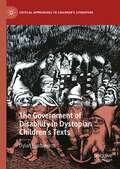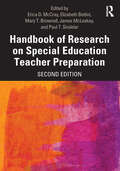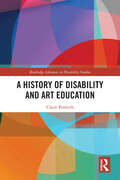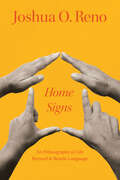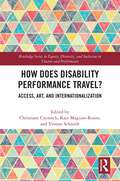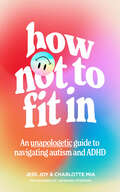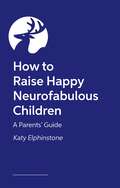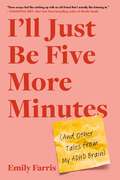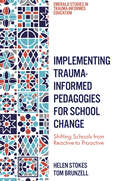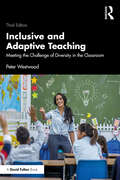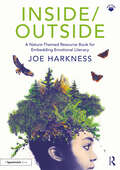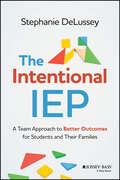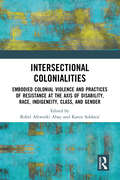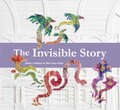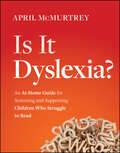- Table View
- List View
The Government of Disability in Dystopian Children’s Texts (Critical Approaches to Children's Literature)
by Dylan HoldsworthThis book takes up the task of mapping discursive shifts in the representation of disability in dystopian youth texts across four historical periods where major social, cultural and political shifts were occurring in the lives of many disabled people. By focusing on dystopian texts, which the author argues act as sites for challenging or reinforcing dominant belief systems and ways of being, this study explores the potential of literature, film and television to act as a catalyst of change in the representation of disability. In addition, this work discusses the texts and technologies that continue to perpetuate questionable and often competing discourses on the subject.
Handbook of Research on Special Education Teacher Preparation
by Erica D. McCray Elizabeth Bettini Mary T. Brownell James McLeskey Paul T. SindelarThe new edition of this landmark text expands our current understanding of teacher education broadly by providing an in-depth look at the most up-to-date research on special education teacher preparation. Offering a comprehensive review of research on attracting, preparing, and sustaining personnel to effectively serve students with disabilities, it is fully updated to align with current knowledge and future perspectives on special educator development, synthesizing what we can do to continue advancing as a field. The Handbook of Research on Special Education Teacher Preparation is a great resource not only to special education faculty and the doctoral students they prepare, but also to scholars outside of special education who address questions related to special education teacher supply, demand, and attrition.
Handbook of Research on Special Education Teacher Preparation
by Erica D. McCray Elizabeth Bettini Mary T. Brownell James McLeskey Paul T. SindelarThe new edition of this landmark text expands our current understanding of teacher education broadly by providing an in-depth look at the most up-to-date research on special education teacher preparation. Offering a comprehensive review of research on attracting, preparing, and sustaining personnel to effectively serve students with disabilities, it is fully updated to align with current knowledge and future perspectives on special educator development, synthesizing what we can do to continue advancing as a field. The Handbook of Research on Special Education Teacher Preparation is a great resource not only to special education faculty and the doctoral students they prepare, but also to scholars outside of special education who address questions related to special education teacher supply, demand, and attrition.
A History of Disability and Art Education (Routledge Advances in Disability Studies)
by Claire PenkethDrawing on recent theoretical frameworks from critical disability studies and art education including normalcy, ableism, disability and Crip theory, this book offers an analysis of the conceptualisation of ability in art education and its relationship with disability. Drawing on the work of Cizek and Lowenfeld in Austria, Ruskin and Richardson in England and Dewey and Eisner in the United States, it critically examines the influence of ideas such as the dominance of vision and visuality; the emergence of psychological perspectives; the Child Art Movement; the implications of assessment regimes; and the relevance of art education as a critical social practice on the production of disability. Offering a sustained inquiry into the differential values attributed to learners and their work and the implications of this for framing our understanding of disability in art education, this book shows that although art educators have frequently advocated for the universal appeal and importance of art education, they have done so within historical contexts that have produced and determined problematic ideas regarding disability. It will be of interest to all scholars and students of disability studies, art in education, art history and education studies.
A History of Disability and Art Education (Routledge Advances in Disability Studies)
by Claire PenkethDrawing on recent theoretical frameworks from critical disability studies and art education including normalcy, ableism, disability and Crip theory, this book offers an analysis of the conceptualisation of ability in art education and its relationship with disability. Drawing on the work of Cizek and Lowenfeld in Austria, Ruskin and Richardson in England and Dewey and Eisner in the United States, it critically examines the influence of ideas such as the dominance of vision and visuality; the emergence of psychological perspectives; the Child Art Movement; the implications of assessment regimes; and the relevance of art education as a critical social practice on the production of disability. Offering a sustained inquiry into the differential values attributed to learners and their work and the implications of this for framing our understanding of disability in art education, this book shows that although art educators have frequently advocated for the universal appeal and importance of art education, they have done so within historical contexts that have produced and determined problematic ideas regarding disability. It will be of interest to all scholars and students of disability studies, art in education, art history and education studies.
Home Signs: An Ethnography of Life beyond and beside Language
by Joshua O. RenoAn intimate account of an anthropologist’s relationship with his non-verbal son and how it has shaped and transformed his understanding of closeness and communication. Home Signs grew out of the anthropologist Joshua Reno’s experience of caring for and trying to communicate with his teenage son, Charlie, who cannot speak. To manage interactions with others, Charlie uses what are known as “home signs,” gestures developed to meet his need for expression, ranging from the wiggle of a finger to a subtle sideways glance. Though he is nonverbal, he is far from silent: in fact, he is in constant communication with others. In this intimate reflection on language, disability, and togetherness, the author invites us into his and Charlie’s shared world. Combining portraits of family life and interviews with other caregivers, Reno upends several assumptions, especially the idea that people who seem not to be able to speak for themselves need others to speak on their behalf. With its broad exploration of nonverbal communication in both human and nonhuman contexts, Home Signs challenges us to think harder about what it means to lead a “normal” life and to connect with another person.
How Does Disability Performance Travel?: Access, Art, and Internationalization (Routledge Series in Equity, Diversity, and Inclusion in Theatre and Performance)
by Christiane Czymoch Kate Maguire-Rosier Yvonne SchmidtThis edited collection investigates the myriad ways in which disability performance travels in a globalized world. Disability arts festivals are growing in different parts of the world; theatre and dance companies with disabled artists are increasingly touring and collaborating with international partners. At the same time, theatre spaces are often not accessible, and the necessity of mobility excludes some disabled artists from being part of an international disability arts community. How does disability performance travel, who does not travel – and why? What is the role of funding and producing structures, disability arts festivals and networks around the world? How do the logics of international (co-)producing govern the way in which disability art is represented internationally? Who is excluded from being part of a touring theatre or dance company, and how can festivals, conferences, and other agents of a growing disability culture create other forms of participation, which are not limited to physical co-presence? This study will contextualize disability aesthetics, arts, media, and culture in a global frame, yet firmly rooted in its smaller national, state, and local community settings and will be of great interest to students and scholars in the field.
How Does Disability Performance Travel?: Access, Art, and Internationalization (Routledge Series in Equity, Diversity, and Inclusion in Theatre and Performance)
This edited collection investigates the myriad ways in which disability performance travels in a globalized world. Disability arts festivals are growing in different parts of the world; theatre and dance companies with disabled artists are increasingly touring and collaborating with international partners. At the same time, theatre spaces are often not accessible, and the necessity of mobility excludes some disabled artists from being part of an international disability arts community. How does disability performance travel, who does not travel – and why? What is the role of funding and producing structures, disability arts festivals and networks around the world? How do the logics of international (co-)producing govern the way in which disability art is represented internationally? Who is excluded from being part of a touring theatre or dance company, and how can festivals, conferences, and other agents of a growing disability culture create other forms of participation, which are not limited to physical co-presence? This study will contextualize disability aesthetics, arts, media, and culture in a global frame, yet firmly rooted in its smaller national, state, and local community settings and will be of great interest to students and scholars in the field.
How Not to Fit In: An Unapologetic Guide To Navigating Autism And Adhd
by Jess Joy Charlotte Mia’The lack of information around how ADHD and autism shows up in adults means that many of us have been assuming we were anxious, not working hard enough, or just entirely failing altogether.’ – Jess Joy and Charlotte Mia
How to Raise Happy Neurofabulous Children: A Parents' Guide
by Katy ElphinstoneParenting can be chaos, a flurry of trial and error, problem-solving, and tears (of difficulty but also of joy!). Katy Elphinstone, an autistic parent who's experienced herself the wonders and the challenges of raising two children, one of whom is autistic, has taken notes on the 'do's' and 'dont's' of parenting when it comes to neurodivergent children.Supportive and refreshingly direct, Katy's advice can be tailored to you and your child's needs. We know there isn't a 'one size fits all' guide to parenting! There's also space to write your thoughts down and organise those tips that work for you.With advice on all the day-to-day experiences such as preparing for school, venturing out to a new place, making friends, and even posing the question, 'Can screentime be a positive?', Neurofabulous is the ultimate guide that gives you everything you need to ensure that you and your child thrive.
I'll Just Be Five More Minutes: And Other Tales from My ADHD Brain
by Emily FarrisA hilariously-honest, heartwarming essay collection about life, love, and discovering you have ADHD at age 35 Despite being a published writer with a family, a gaggle of internet fans, and (most shockingly) a mortgage, Emily Farris could never get her sh*t together. As she saw it, disorganization was one of her countless character flaws—that is until she was diagnosed with ADHD at age 35. Like many girls who go undiagnosed, Emily grew up internalizing criticisms about her impulsivity and lack of follow-through. She held onto that shame as she tried (and often failed) to fit into a world designed for neurotypical brains. I'll Just Be Five More Minutes is a personal essay collection of laugh-out-loud-funny, tear-jerking, and at times cringey true stories of Emily's experiences as a neurodivergent woman. With the newfound knowledge of her ADHD, Emily candidly reexamines her complicated relationships (including one with a celebrity stalker), her money problems, the years she spent unknowingly self-medicating, and her hyperfixations (two words: decorative baskets). A memoir-in-essays both entertaining and enlightening, I'll Just Be Five More Minutes is for people with ADHD, as well as those who know and love them. This is a powerful collection of deeply relatable, wide-ranging stories about a woman's right to control her own body, about overwhelm and oversharing, about drinking too much and sleeping too little, and about being misunderstood by the people closest to you. At its heart, I&’ll Just Be Five More Minutes is about not quite fitting in and not really understanding why—something we&’ve all felt whether we're neurodivergent or not.
Implementing Trauma-Informed Pedagogies for School Change: Shifting Schools from Reactive to Proactive (Emerald Studies in Trauma-Informed Education)
by Helen Stokes Tom BrunzellThe area of trauma-informed positive education (TIPE) is a recently emerging field in educational studies. Schools serving communities contending with educational inequity have many students identified as trauma-affected, with significant unmet learning and social emotional needs. This groundbreaking study and first book in the Emerald Studies in Trauma-Informed Education series is the first longitudinal research in trauma informed positive education, and the first research to link the professional learning and ongoing implementation of TIPE pedagogical practices to changed student perceptions of school and collective teacher efficacy over a four-year period. Providing examples of how schools implement TIPE and using case studies from two schools that were experiencing difficulty with their delivery of learning and wellbeing outcomes for students, the authors explore how implementing TIPE pedagogical practices can bring about school change. There is a focus on student wellbeing, collective teacher efficacy and assisting students to be ready to learn. The case studies that are explored will be of interest to school practitioners and system leaders working with students who are are not yet ready to learn and disengaged from school.
Implementing Trauma-Informed Pedagogies for School Change: Shifting Schools from Reactive to Proactive (Emerald Studies in Trauma-Informed Education)
by Helen Stokes Tom BrunzellThe area of trauma-informed positive education (TIPE) is a recently emerging field in educational studies. Schools serving communities contending with educational inequity have many students identified as trauma-affected, with significant unmet learning and social emotional needs. This groundbreaking study and first book in the Emerald Studies in Trauma-Informed Education series is the first longitudinal research in trauma informed positive education, and the first research to link the professional learning and ongoing implementation of TIPE pedagogical practices to changed student perceptions of school and collective teacher efficacy over a four-year period. Providing examples of how schools implement TIPE and using case studies from two schools that were experiencing difficulty with their delivery of learning and wellbeing outcomes for students, the authors explore how implementing TIPE pedagogical practices can bring about school change. There is a focus on student wellbeing, collective teacher efficacy and assisting students to be ready to learn. The case studies that are explored will be of interest to school practitioners and system leaders working with students who are are not yet ready to learn and disengaged from school.
Inclusive and Adaptive Teaching: Meeting the Challenge of Diversity in the Classroom
by Peter WestwoodThis new edition of Inclusive and Adaptive Teaching from bestselling author Peter Westwood continues to provide a range of practical strategies for advancing the learning and development of all students in inclusive classrooms. Drawing on the most recent international research into teaching methods, Westwood presents a range of evidence-based strategies for adapting curriculum content, modifying learning activities and resources, and for making any necessary accommodations during assessment. Revised topics in this third edition include a focus on the implications of diversity and exceptionality, the progress made to date in providing inclusive schooling, a presentation of evidence-based methods for teaching mixed-ability classes and ideas for adapting the curriculum and designing teaching materials. New topics in this revised edition include: • how to support students’ self-determination and autonomy; • LGBTQ+ issues for inclusive schools; • the UK ‘engagement model’ for assessing very low-functioning children; • the concept and purposes of a ‘flipped classroom’; • engaging with a Response-to-Intervention Model; • how to support students in vocational colleges and universities. Each chapter contains an up-to-date list of online and print resources available to teachers who wish to pursue topics in greater depth. This text is an invaluable resource for both practicing and trainee teachers and teaching assistants, as well as school principals, school counsellors and educational psychologists.
Inclusive and Adaptive Teaching: Meeting the Challenge of Diversity in the Classroom
by Peter WestwoodThis new edition of Inclusive and Adaptive Teaching from bestselling author Peter Westwood continues to provide a range of practical strategies for advancing the learning and development of all students in inclusive classrooms. Drawing on the most recent international research into teaching methods, Westwood presents a range of evidence-based strategies for adapting curriculum content, modifying learning activities and resources, and for making any necessary accommodations during assessment. Revised topics in this third edition include a focus on the implications of diversity and exceptionality, the progress made to date in providing inclusive schooling, a presentation of evidence-based methods for teaching mixed-ability classes and ideas for adapting the curriculum and designing teaching materials. New topics in this revised edition include: • how to support students’ self-determination and autonomy; • LGBTQ+ issues for inclusive schools; • the UK ‘engagement model’ for assessing very low-functioning children; • the concept and purposes of a ‘flipped classroom’; • engaging with a Response-to-Intervention Model; • how to support students in vocational colleges and universities. Each chapter contains an up-to-date list of online and print resources available to teachers who wish to pursue topics in greater depth. This text is an invaluable resource for both practicing and trainee teachers and teaching assistants, as well as school principals, school counsellors and educational psychologists.
Inside/Outside: A Nature-Themed Resource Book for Embedding Emotional Literacy
by Joe HarknessInside/Outside is a unique educational resource for those working with young people of secondary school age, providing a variety of tried-and-tested indoor and outdoor lessons and activities to promote and embed emotional literacy. The book is divided into three accessible sections: emotions and feelings; self and situation; and mental health and wellbeing; which each cover a variety of themes, from anxiety and depression, to happiness, communication, and confidence. For each theme, ‘inside’ and ‘outside’ activities are offered, with inside activities inspiring students to self-reflect and develop empathy for others, and those outside drawing heavily on nature and learning outside the classroom. The ‘outside’ activities are adaptable and have been designed to work in any available outdoor space, and all activities can be used either in standalone lessons or sequentially, with introductory tasks, group activities, and circle time discussions. With a focus on equipping students with meaningful and tangible skills to support them in the recognition, identification, and expression of their emotions, Inside/Outside will be a valuable resource for teachers, youth workers, home-educators and anyone else looking to facilitate nature connection and introspection in children aged eleven to sixteen.
Inside/Outside: A Nature-Themed Resource Book for Embedding Emotional Literacy
by Joe HarknessInside/Outside is a unique educational resource for those working with young people of secondary school age, providing a variety of tried-and-tested indoor and outdoor lessons and activities to promote and embed emotional literacy. The book is divided into three accessible sections: emotions and feelings; self and situation; and mental health and wellbeing; which each cover a variety of themes, from anxiety and depression, to happiness, communication, and confidence. For each theme, ‘inside’ and ‘outside’ activities are offered, with inside activities inspiring students to self-reflect and develop empathy for others, and those outside drawing heavily on nature and learning outside the classroom. The ‘outside’ activities are adaptable and have been designed to work in any available outdoor space, and all activities can be used either in standalone lessons or sequentially, with introductory tasks, group activities, and circle time discussions. With a focus on equipping students with meaningful and tangible skills to support them in the recognition, identification, and expression of their emotions, Inside/Outside will be a valuable resource for teachers, youth workers, home-educators and anyone else looking to facilitate nature connection and introspection in children aged eleven to sixteen.
The Intentional IEP: A Team Approach to Better Outcomes for Students and Their Families
by Stephanie DeLusseyLearn how to put together IEPs with the power to make a real difference for students The Intentional IEP shows special education teachers how to successfully collaborate with all stakeholders—parents or guardians, general ed teachers, therapists, and beyond—to work toward students’ success. Too many of us aren’t trained to write the Individualized Education Programs that help millions of students with thrive in school. This book fills that training gap, explaining the importance of assembling an IEP team and inviting this team to confront and improve its current processes and habits to make IEP writing simpler and more effective. With all the pressures that educators are under, it’s easy to cut corners when it comes time towrite IEPs. Writing them in isolation, leaving them to the night before, making decisions without consulting data and research, letting family collaboration fall to the wayside—most special educators have made these mistakes at some point. The Intentional IEP equips you with the resources you need to feel confident in approaching IEPs the right way, including prioritizing the many competing demands you face so you can find the capacity to show up for your students. This book offers: Clear, step-by-step solutions for all IEP members that can easily be implemented at any time during the school year Collaboration strategies for IEP teammates to rely on one another for expert and professional knowledge Tools and reproducibles to strengthen practices and overcome common hurdles Direct advice from a veteran special education teacher who has seen what a difference collaboration in the IEP can make for studentsThe Intentional IEP is a timely resource for special education teachers, general education teachers, and support staff, as well as teachertraining programs. Parents and guardians with students will also benefit from this clearly written guide to the IEP.
The Intentional IEP: A Team Approach to Better Outcomes for Students and Their Families
by Stephanie DeLusseyLearn how to put together IEPs with the power to make a real difference for students The Intentional IEP shows special education teachers how to successfully collaborate with all stakeholders—parents or guardians, general ed teachers, therapists, and beyond—to work toward students’ success. Too many of us aren’t trained to write the Individualized Education Programs that help millions of students with thrive in school. This book fills that training gap, explaining the importance of assembling an IEP team and inviting this team to confront and improve its current processes and habits to make IEP writing simpler and more effective. With all the pressures that educators are under, it’s easy to cut corners when it comes time towrite IEPs. Writing them in isolation, leaving them to the night before, making decisions without consulting data and research, letting family collaboration fall to the wayside—most special educators have made these mistakes at some point. The Intentional IEP equips you with the resources you need to feel confident in approaching IEPs the right way, including prioritizing the many competing demands you face so you can find the capacity to show up for your students. This book offers: Clear, step-by-step solutions for all IEP members that can easily be implemented at any time during the school year Collaboration strategies for IEP teammates to rely on one another for expert and professional knowledge Tools and reproducibles to strengthen practices and overcome common hurdles Direct advice from a veteran special education teacher who has seen what a difference collaboration in the IEP can make for studentsThe Intentional IEP is a timely resource for special education teachers, general education teachers, and support staff, as well as teachertraining programs. Parents and guardians with students will also benefit from this clearly written guide to the IEP.
Intersectional Colonialities: Embodied Colonial Violence and Practices of Resistance at the Axis of Disability, Race, Indigeneity, Class, and Gender (Interdisciplinary Disability Studies)
by Robel Afeworki Abay Karen Soldati 263This book provides a rich synthesis of empirical research and theoretical engagements with questions of disability across different practices of colonialism as historically defined – post/de/anti/settler colonialism.It synthesises, critiques, and expands the boundaries of existing disability research which has been undertaken within different colonial contexts through the rich examination of recent empirical work mapping across disability and its intersectional colonialities. Filling an existing gap within the international literature through embedding the importance of grounding these within scholarly debates of colonialism, it empirically demonstrates the significance of disability for the broader scholarly fields of postcolonial, decolonial, and intersectional theories.It will be of interest to all scholars and students of disability studies, sociology, critical studies, sociology of race and ethic relations, intersectionality, postcolonial and decolonial studies, and human geography.
Intersectional Colonialities: Embodied Colonial Violence and Practices of Resistance at the Axis of Disability, Race, Indigeneity, Class, and Gender (Interdisciplinary Disability Studies)
by Karen Soldatić Robel Afeworki AbayThis book provides a rich synthesis of empirical research and theoretical engagements with questions of disability across different practices of colonialism as historically defined – post/de/anti/settler colonialism.It synthesises, critiques, and expands the boundaries of existing disability research which has been undertaken within different colonial contexts through the rich examination of recent empirical work mapping across disability and its intersectional colonialities. Filling an existing gap within the international literature through embedding the importance of grounding these within scholarly debates of colonialism, it empirically demonstrates the significance of disability for the broader scholarly fields of postcolonial, decolonial, and intersectional theories.It will be of interest to all scholars and students of disability studies, sociology, critical studies, sociology of race and ethic relations, intersectionality, postcolonial and decolonial studies, and human geography.
The Invisible Story
by Jaime GamboaThe world is full of stories. Some are as long as lizards, others so short that they never even make it to The End. But the invisible story is unlike any other story because no one has ever read it! It lives hidden in the darkest corner of the library, far from where the famous tales, written in gold letters, shine. One day, a blind reader approaches the story’s trembling pages. This reader is unlike any reader the invisible story has ever encountered. And when she runs her fingertips over the book’s white pages, it is astonished by what she finds. A beautifully inclusive tale about sight-loss in which we learn that not all stories are meant to be read with the eyes.
The Invisible Story
by Jaime GamboaThe world is full of stories. Some are as long as lizards, others so short that they never even make it to The End. But the invisible story is unlike any other story because no one has ever read it! It lives hidden in the darkest corner of the library, far from where the famous tales, written in gold letters, shine. One day, a blind reader approaches the story’s trembling pages. This reader is unlike any reader the invisible story has ever encountered. And when she runs her fingertips over the book’s white pages, it is astonished by what she finds. A beautifully inclusive tale about sight-loss in which we learn that not all stories are meant to be read with the eyes.
Is It Dyslexia?: An At-Home Guide for Screening and Supporting Children Who Struggle to Read
by April McMurtreyHands-on resources for screening readers of all ages for dyslexia In Is It Dyslexia?, certified dyslexia assessment specialist April McMurtrey delivers an accessible, hands-on framework for screening readers of various ages for dyslexia.. The book offers comprehensive, clear, and step-by-step processes you can apply immediately to confidently and accurately screen readersfor dyslexia. The author shares the tools and strategies used by professional screeners, as well as first, next, and final steps you can take as you move forward with your screening results. The book includes: Explanations of what dyslexia is, as well as an overview of common talents and strengths often found in readers with dyslexia A collection of recommended accommodations for students with dyslexia in the home and school and effective literacy instruction for students with dyslexia A comprehensive dyslexia questionnaire, eleven different screening tests, and step-by-step instructions for administering themIdeal for tutors, homeschool teachers, parents, instructional coaches, counselors, and speech-language therapists, Is It Dyslexia? comes complete with reproducibles and links to video tutorials required for screening students of various ages.
Is It Dyslexia?: An At-Home Guide for Screening and Supporting Children Who Struggle to Read
by April McMurtreyHands-on resources for screening readers of all ages for dyslexia In Is It Dyslexia?, certified dyslexia assessment specialist April McMurtrey delivers an accessible, hands-on framework for screening readers of various ages for dyslexia.. The book offers comprehensive, clear, and step-by-step processes you can apply immediately to confidently and accurately screen readersfor dyslexia. The author shares the tools and strategies used by professional screeners, as well as first, next, and final steps you can take as you move forward with your screening results. The book includes: Explanations of what dyslexia is, as well as an overview of common talents and strengths often found in readers with dyslexia A collection of recommended accommodations for students with dyslexia in the home and school and effective literacy instruction for students with dyslexia A comprehensive dyslexia questionnaire, eleven different screening tests, and step-by-step instructions for administering themIdeal for tutors, homeschool teachers, parents, instructional coaches, counselors, and speech-language therapists, Is It Dyslexia? comes complete with reproducibles and links to video tutorials required for screening students of various ages.
